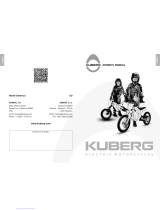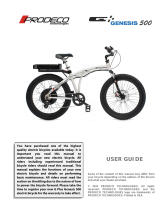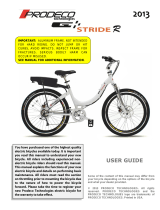
1
HEADLINECONTENTS
SAFETY WARNINGS
1
AN IMPORTANT MESSAGE TO PARENTS:
The Dash freewheeling & electric assist balance bike is intended to allow
younger children to learn and to enjoy and develop their early experiences
using ride-on toys. Studies suggest that children at age 3 have the
coordination required to use a steering wheel or handlebar and can use
a 2-wheeled product. The Dash is designed to help children learn and
develop skills of balance and motion by starting in a non-powered mode and
developing, with appropriate supervision and familiarity, the skills to move
into low speed electric learning opportunities so that a child can develop
riding skills that can be built upon in years to come.
Adult supervision is required as children learn and grow because children do
not understand the risks of riding in areas with cars and are at a very high
risk of falling off and injuring themselves as they first experience the fun –
the needed skills and the risks – of riding something using first their own
power, then electric power. Protecting children as they learn is an important
part of the developmental process.
There are three modes available for riding this product: First, there is a
non-powered, free-wheeling mode that is best for younger, novice riders,
recommended for a minimum age of thirty (30) months; For riders who have
mastered foot-powered riding, parents have the ability to adjust the product to
allow either of the two electric-assisted modes – a lower speed mode (up to
3 mph, 5 km/h) and a slightly higher speed mode (up to 5 mph, 8 km/h). These
adjustments require adult attention as descried in the manual (see pages 5 & 7)
This manual contains important information. For your child’s safety, it is your
responsibility to review this information and make sure that you instruct
your child to follow all warnings, cautions, instructions, and safety topics.
Razor USA recommends that you periodically review and reinforce the
information in this manual with younger riders, and that you inspect and
maintain your child’s product to ensure their safety.
WARNING: PARENTAL AND ADULT RESPONSIBILITY AND
SUPERVISION IS NECESSARY: Riding a Dash freewheeling &
electric assist balance bike does present potential risks and caution is
required. Because products, like the Dash, can and do present potential
hazards plainly associated with their use, it is well recognized THE NEED
FOR EXERCISE OF PARENTAL RESPONSIBILITY IN SELECTING RIDING
PRODUCTS APPROPRIATE TO THE AGE OF A CHILD, OR PARENTAL
SUPERVISION IN SITUATIONS IN WHICH CHILDREN OF VARIOUS AGES
MAY HAVE ACCESS TO THE SAME RIDING PRODUCTS, IS IMPORTANT.
Not every product is appropriate for every age or size of child, and different
age recommendations are found within this category of product which are
intended to reflect the nature of the hazards and the expected mental or
physical ability, or both, of a child to cope with the hazards.
Keep this product away from very small children and remember
that it is intended for use only by children who are, at a minimum,
completely comfortable and competent while operating the Dash.
Children with any mental or physical conditions that may make them
susceptible to injury, impair their physical dexterity or mental capabilities
to recognize, understand, and follow safety instructions and to be able to
understand the hazards inherent in Dash use, should not use or be permitted
to use products inappropriate for their abilities.
WARNING: Riding 2-wheeled products, such as this balance bike can
be a hazardous activity. Certain conditions may cause the equipment to
fail without fault of the manufacturer. Such products can and are intended
to move, and it is therefore possible to lose control, fall off and/or get into
dangerous situations that no amount of care, instruction or expertise can
eliminate. If such things occur, you can be seriously injured or die, even when
using safety equipment and other precautions. LIKE ANY OTHER MOVING
PRODUCT, USING THIS PRODUCT CAN BE A DANGEROUS ACTIVITY AND
MAY RESULT IN INJURY OR DEATH EVEN WHEN USED WITH PROPER
SAFETY PRECAUTIONS. RIDE AT YOUR OWN RISK AND USE COMMON
SENSE.
This manual contains many warnings and cautions concerning the
consequences of failing to maintain, inspect or properly use your Razor
product. Because any incident can result in serious injury or even death, we
do not repeat the warning of potential serious injury or death each time such
a possibility is mentioned.
• This product does not have a brake.
• Do not allow children under age thirty (30) months to use this product.
Direct adult supervision is required at all times. The recommended rider
age of thirty (30) months and older for Dash is only an estimate, and can
be affected by the rider’s size, weight, or skills. Any rider unable to fit
comfortably on the Dash should not attempt to ride it.
• Manufacturer’s suggested minimum rider age is thirty (30) months in the
Freewheeling (non-powered) Mode and three (3) years in the Electric
Assist Mode. The default setting is Freewheeling Mode.
• Always pay attention to where your child is going; do not allow use of the
throttle to distract rider from safe riding practices.
• Safety equipment, such as helmet, knee pads and elbow pads are
recommended. Always ensure your child is wearing a helmet when riding
this product and keep the chinstrap securely buckled.
• Always wear closed toe shoes.
• Ride on smooth, paved surfaces without loose debris, such as rocks or
gravel, and away from motor vehicles.
• Avoid sharp bumps, drainage grates, and sudden surface changes as this
product may suddenly stop.
• Avoid streets and surfaces with water, puddles, mud, ice, sand, gravel, leaves
and other debris. Wet weather impairs traction, stopping, and visibility.
• Do not ride at night or when visibility is impaired.
• Avoid excessive speed associated with downhill rides.
• Obey all local traffic laws and regulations.
• Watch out for pedestrians.
• DO NOT EXCEED 44 LB (20 KG) TOTAL WEIGHT ON THIS
RAZOR PRODUCT.
•RIDER WEIGHT DOES NOT NECESSARILY MEAN A CHILD’S SIZE IS
APPROPRIATE TO FIT OR MAINTAIN CONTROL OF THIS PRODUCT.
• A parent’s decision to allow his or her child to ride this product should
be based on the child’s maturity, skill, and ability to follow rules.
Safety Warnings .............................................................................................1-2
Before You Begin ............................................................................................... 3
Assembly and Set-Up ........................................................................................ 4
Changing the Mode ...........................................................................................5
Changing the Speed Mode ...............................................................................5
Charging the Battery ......................................................................................... 6
Usage .................................................................................................................7
Repair and Maintenance ................................................................................... 8
Product Parts Breakdown .................................................................................9
















